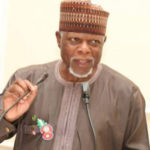What is however frightening news, is the intention of the Legislative arm of government, to establish 80 new federal institutions of higher learning in Nigeria. The intention of the sponsors of the various bills currently before both chambers of the National Assembly is said to be the siting of such federal institutions in every state of the federation. Reporting this development, the Daily Trust stated as follows:
“Eighty bills for new federal tertiary institutions are at various stages of the legislative processes at the Senate and House of Representatives. The proposed 80 institutions are spread across 36 states and FCT. They include 27 universities, 22 colleges of education, 19 polytechnics, six institutes, one police academy, one federal college of agriculture, one college of forestry, one paramilitary academy, one federal college of veterinary assistants as well as a school of mines and geological studies.
Lagos-Ibadan rail completion now February ― FG
“Out of the 27 proposed varsities, 10 are for education, 8 for agriculture, 4 for technology, and one each for science and tech, medicine and medical sciences, aquatic studies and health. While 37 of the 80 bills emanated from the Senate, 36 from the House of Representatives. Since the Senate on January 23, 2018 approved its Committee on Tertiary Institutions and TETFund’s report on modalities of establishing federal institutions which stated that such shall be established only in states where they do not already exist, there has been a surge of private bills particularly in the Senate seeking to establish new tertiary institutions.”
To say that this gives serious cause for concern would be an understatement. From experience, the major incentive for the establishment of new universities is in Nigeria to have them sited in the constituencies of the law makers who sponsor such bill. Issues such as whether such institutions are really needed and more importantly how they will be funded are not given due consideration. In developed countries, the establishment of universities is driven by the need to have them in place with the focus entirely on quality rather than quantity. In stating this, I am not unaware that one of the reasons given by sponsors of the bills is the high number of candidates who yearly seek admission into Nigerian higher institutions of learning and the fact that a high number of the applicants are usually not successful. However, in my estimation, the solution cannot be the creation of new universities. The focus, on the contrary, should be how to increase the capacity of the existing institutions through improved funding, to enable them absorb more students.
As stated earlier, university lecturers have been on strike since 4th November. What sense is there, one is compelled to ask, in the quest to establish more institutions when the current ones have almost been rendered comatose and are even sometimes referred to as no more than glorified secondary schools? To bring home this point, it is pertinent to refer to some of the reasons already cited for the current strike action of ASUU. They include: 1. Less than 10 per cent of the universities have video conferencing facility. 2. Less than 20 per cent of the universities use Interactive Boards. 3. More than 50 per cent don’t use public address system in their overcrowded lecture rooms/theatres. 4. Internet services are non-existent,or epileptic and slow in 99 per cent of Nigerian universities.
- Nigerian universities library resources are outdated and manually operated. Book shelves are homes to rats/cockroaches. 6. No university library in Nigeria is fully automated. Less than 35 per cent are partially automated.7. 701 Development projects in Nigerian universities 163 (23.3 per cent) are abandoned 538 (76.7 per cent) are perpetually ongoing projects. 8. Some of the abandoned projects in Nigerian universities are over 15 years old, some are over 40 years old.
- 76 per cent of Nigerian universities use well as source of water, 45 per cent use pit latrine, 67 per cent of students use bush as toilet.
- UNN and UDUS have the highest number of abandoned projects (22 and 16 respectively). 11. All NDDC projects across universities in Niger Delta States are abandoned. About 84.6 per cent of them are students’ hostels 12. 77 per cent of Nigerian universities can be classified as “Glorified Primary Schools” Laboratories are non existent 13. There are 8 on-going projects at the Nasarawa State University, Keffi. None of them is funded by the State Government 14. 80 per cent of Nigerian Universities are grossly under-staffed 15. 78 per cent of Nigerian Universities rely heavily on part-time and visiting lecturers 16. 88 per cent of Nigerian Universities have under-qualified Academics 17. 90 per cent of Nigerian universities are bottom-heavy (with junior lecturers forming large chunk of the workforce)
- Only 2 per cent of Nigerian Universities attract expatriate lecturers, over 80 per cent of Ghanian Universities attract same 19. Lecturer student ratio: National Open University of Nigeria 1:363 University of Abuja 1:122 Lagos State University 1:111Compared with Harvard 1:4; MIT 1:9; Yale 1:4, Cambridge 1:3; NUS 1:12; KFUPM 1:9; Technion 1:15). 20. Nigerian Universities Instead of having 100 per cent academics having PhDs, only about 43 per cent do so. The remaining 57 per cent have no PhDs.
- Nigerian university medical students are trained in the most dangerous environment, some only see medical tools in books 22. Only 7 Nigerian Universities have up to 60 per cent of their teaching staff with PhD qualifications 23. While majority of the universities in the country are grossly understaffed, a few cases present a pathetic picture 24. There are universities in Nigeria which the total number of Professors is not more than Five (5) 25. Make-shift lecturing system: Out of a total of 37,504 lecturers, only 28,128 (75 per cent) are engaged on full-time basis. 26.9,376 (25 per cent) Nigerian Lecturers are recycled as visiting, adjunct, sabbatical and contract lecturers.
- 700 Ex-millitants in Nigeria are receiving more funds annually than 20 Nigerian universities 28. More expenditure is incurred in administration & routine functions than in core academic matters in Nigerian universities 29. There are 77, 511 full-time non-teaching staff in Nigeria’s public universities 2 times number of academic staff 30. There is no relationship between enrolment and the tangible manpower needs of Nigeria.
- Nigerian universities have horrible hostel facilities, overcrowded, overstretched lavatory and laundry facilities, poor sanitation,etc 32. Except Nigerian Defence Academy Kaduna, no university in Nigeria is able to accommodate more than 35 per cent of its students. 33. Some universities (e.g. MOUAU),female students take their bath in the open because the bathrooms are in very poor condition. 34. Laundries and common rooms in many universities have been converted into rooms where students live, in open prison style.
- Most state universities charge commercial rates for unfit and unsuitable hostel accommodation 36. In off-campus hostels, students are susceptible to extraneous influences and violence prostitution, rape, gang violence 37. Nigerian University Students sitting on bare floor or peeping through windows to attend lectures 38. Over 1000 students being packed in lecture halls meant for less than 150 students 39. Over 400 Nigerian university students being packed in laboratory meant for 75 students
- University administrators spend millions to erect super-gates when their Libraries are still at foundation level; expend millions to purchase exotic vehicles for university officers even though they lack basic classroom furnishings; spend hundreds of millions in wall-fencing and in-fencing when students accommodation is inadequate and in tatters; 41. Govt spending hundreds of millions on mundane administration cost instead of providing boreholes and power supplements; Govt hiring personal staff, including Personal Assistants,j Advisers, Bodyguards, Personal Consultants, etc.
Given the above, it is not difficult to see how absurd the idea for the creation of 80 additional universities is and why it must as matter of urgency be abandoned. Next will I will discuss the perennial issue of inadequate funding of education and why rather than create more problems by the establishment of new universities, the government should focus on bringing about an enabling environment for interested individuals to establish non-profit educational institutions.
To be continued…
Please send your comment or contribution to president@abuad.edu.ng
AARE AFE BABALOLA SAN, CON






